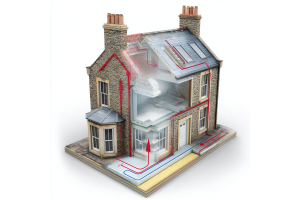
Introduction: Why “Warmth” is More Than Just Physical Comfort
When we think of home heating, we often consider only the physical side: keeping rooms warm and avoiding the chill. But warmth isn’t just about temperature. It’s also psychological, emotional and even biological.
In this article, we’ll explore how warmth (and its absence) affects our mood, mental health and overall wellbeing — and, importantly for Geyser readers, how your heating system and indoor environment tie into that connection.
1. The Science of Temperature, Mood & Mental Health
1.1 Ambient Temperature & Daily Mood
Research shows that ambient temperature exerts a measurable impact on mood. For instance, a Swiss study found that for every 5 °C increase in daily maximum temperature, the chance of a “bad mood” decreased by about 7% in the general population.
That said — this doesn’t mean “hotter is always better.” The same study found that among people with certain psychiatric disorders (anxiety, depression, schizophrenia) the pattern was different — sometimes worse mood with rising temperature.
1.2 Temperature Extremes, Stress & Mental Health Risks
Extreme cold or extreme heat both carry mental-health risks.
-
A systematic review found that high ambient temperatures are associated with higher rates of hospital admissions for mood disorders, anxiety, and even increased suicide risk.
-
Research on indoor temperatures shows that inadequate warmth (e.g., cold homes) is tied to higher rates of mental-health symptoms — e.g., stress, anxiety, lower wellbeing.
1.3 Indoor Thermal Environment & Well-being
Since many of us spend a large portion of time indoors, the indoor thermal environment matters a lot.
-
A review of indoor temperature and health outcomes concluded that inadequate indoor temperatures (too cold or too hot) are linked with poorer health, including mental-health outcomes.
-
Another study pointed out that psychological state (mood, perception) is a key factor in how people feel about indoor thermal comfort (not just the physical temperature).
2. How Warmth Influences Mood & Mental Health — Mechanisms
Here are some of the pathways through which warmth (or lack thereof) can influence mood and mental health.
2.1 Physiological & Biological Mechanisms
-
Temperature extremes strain the body’s thermoregulation, causing stress on cardiovascular and nervous systems. This can lead to fatigue, reduced cognitive function, irritability.
-
Warmth affects sleep: poor sleep is a known risk factor for mood disorders and anxiety. For example, hot nights disrupt sleep quality.
-
Indoor cold may increase stress hormone (cortisol) levels and reduce energy-levels, contributing to feelings of low mood or anxiety. (Suggested in indoor temperature reviews.)
2.2 Psychological & Perception Mechanisms
-
There is a psychological link between physical warmth/cold and emotional warmth/cold. For example, research by John A. Bargh and colleagues found that holding a warm object can lead to more prosocial feelings (“warmth”), whereas cold can lead to feelings of social distance or even loneliness.
-
The perception of thermal comfort itself affects mood: if you feel physically uncomfortable (too cold/too hot), you’re more likely to feel irritated, stressed or less able to concentrate.
2.3 Behavioural & Social Mechanisms
-
When the indoor (or outdoor) environment is uncomfortable, people may avoid socialising, reduce physical activity, or stay indoors in poor conditions — which can worsen mood and reduce resilience.
-
Both heat and cold extremes can reduce access to coping strategies (exercise, social connection, nature) which protect mental health.
2.4 The Role of Warmth in Building Resilience & Comfort
Warm environments can help by:
-
Encouraging social connection (people feel comfortable spending time together)
-
Supporting restful sleep
-
Enabling comfortable physical activity (walking, moving around)
-
Reducing the sensory stress of discomfort that pulls attention away from emotional/mental regulation
3. What This Means for Home & Heating — Practical Implications
Since you’re visiting Geyser.co.uk, it’s useful to see how all this relates to your home, heating system, indoor comfort, and mental well-being.
3.1 Setting a Healthy Indoor Temperature Range
-
Aim for an indoor ambient temperature that’s comfortable without feeling too warm or too cold. According to thermal-comfort research, the “neutral” zone often lies around 20-24°C for many people, although individual preference and clothing levels vary.
-
Night-time temperatures matter for sleep. Having a slightly cooler room at night is good, but if it’s too warm (especially if outdoor heat enters), sleep gets disrupted, compromising mood.
3.2 Ensuring Reliable Heating & Avoiding “Cold Homes”
-
Inadequate heating (or poorly insulated homes) means occupants spend more time in sub-optimal thermal conditions, which is linked to worse mental-health outcomes.
-
Ensuring your heating system is efficient, responsive, and able to maintain a stable temperature helps reduce thermal stress (and thus, potential impacts on mood).
3.3 Considering Seasonal & Weather Variations
-
While much research focuses on heat (or heat waves), cold and fluctuations (warm days, cold nights) can also stress occupants. For example, during cold seasons a higher ambient temperature correlated with lower reported stress in a Swiss study.
-
For a UK home (where winters are chilly but not extreme compared to some countries), ensuring consistent indoor warmth and avoiding large fluctuations is key.
3.4 Integrating Comfort, Well-being & Home Environment
-
Think beyond just “turning the boiler up”. Consider insulation, draughts, glazing, humidity, ventilation — these all affect perceived warmth and comfort.
-
A home that feels comfortable supports mental-wellbeing: less time dealing with discomfort, less distraction from low-level stress, better rest, better mood.
3.5 Practical Tips for Residents & Home-Owners
-
Use thermostats and timers to maintain consistent temperature, especially during morning/evening when people are most vulnerable (less activity).
-
In living spaces, aim for around 20-22°C as a comfortable general target, adjusting based on personal comfort and room usage.
-
At night, slightly cooler can promote sleep — but avoid letting rooms drop too low (e.g., below ~16-17°C) especially if you’re at risk of cold discomfort.
-
Ensure rooms are well-insulated and free of draughts to reduce energy costs and improve thermal comfort (which ties indirectly into mental comfort).
-
If your home overheats (sunlight, poor ventilation) consider shading or ventilation — because excessive warmth can disturb sleep and mood, too.
-
Use heating systems smartly: zoning (only heating the rooms you use), reliable controls, and feedback (thermostats you can trust).
-
Spend time in comfortable, warm rooms when resting or socialising — the feeling of comfort supports emotional wellbeing.
4. Myths & Nuances: What to Be Aware Of
4.1 “Warmer is Always Better” — Not Always
It might seem intuitive that warmer temperatures improve mood, but the evidence is nuanced:
-
Some research shows rising temperature lowers bad-mood risk in the general population, but people with pre-existing mental-health conditions may respond differently.
-
Excessive heat (especially without proper cooling) can impair sleep, concentration and increase irritability.
Thus the key is comfort and stability rather than simply “higher temperature”.
4.2 Individual Variation Matters
-
Age, health status, sensitivity, medications (especially psychotropic ones) all affect how someone responds to thermal conditions. For example, older adults often regulate body temperature less well and are more sensitive to cold or heat stress.
-
Thermal comfort is personal: two people in the same room may feel differently about the temperature, which underscores why good heating systems and controls matter.
4.3 The Role of Humidity, Air Flow & Other Environmental Factors
Temperature isn’t the only factor: humidity, air movement, radiant heat (from windows), insulation, etc., all affect how people perceive “warmth” or “cold”.
For instance, a room at 20°C but very humid or draughty may feel colder (and therefore impact mood) than a well-insulated room at the same temperature.
4.4 Psychological & Social Factors Also Influence Mood
Even in a comfortable thermal environment, other factors (isolation, lack of sleep, stress, environment) affect mental health. The thermal environment is one piece of the puzzle, not the whole thing.
5. Why Geyser’s Heating Solution Matters to Mental & Emotional Well-Being
At Geyser, you specialise in providing high-quality home heating solutions — not just for physical warmth but for well-being.
Here’s how your work links directly to the links between warmth, mood and mental health:
-
By providing efficient, reliable heating systems, you help create indoor environments where occupants feel thermally comfortable, safe and at ease — which supports better mood and resilience.
-
By advising on heating controls, thermostats, insulation, you’re helping avoid thermal discomfort (too cold, too hot), which could otherwise add hidden stress to a household.
-
By emphasising the importance of indoor comfort (including at night) you help your clients maintain better sleep, better mood, fewer irritations or energy drains due to fighting the cold.
-
By offering tailored solutions (zoning, modern controls, smart heating), you help households adapt their environment — which is particularly important when individual comfort or health needs vary (e.g., older residents, people working from home, etc.).
-
By linking the concept of “home comfort” with mental and emotional wellbeing, you position yourself not merely as a heating provider, but as a partner in household health.
6. Key Takeaways & Action List
Key Takeaways
-
Thermal comfort (neither too cold nor too hot) supports better mood and mental well-being.
-
Both extremes of temperature (high heat or low cold) carry risks for mood, sleep, mental health.
-
Indoor environment matters a lot — heating, insulation, ventilation all affect the thermal comfort and thus indirectly mental health.
-
For homeowners, paying attention to heating systems, controls, insulation, and thermal comfort isn’t just about cost or energy — it’s about wellbeing.
-
Comfort → rest, activity, socialising → positive mood → resilience.
-
Your heating solution is part of the holistic environment of wellbeing.
Practical Action List for Homeowners/Readers
-
Set your thermostat to a comfortable, stable temperature (e.g., ~20-22°C in living areas; cooler at night but not too cold).
-
Avoid large swings in temperature (e.g., room extremely cold now, then heating full blast).
-
Ensure your home is well insulated, draughts are sealed, windows and doors are efficient.
-
Use heating zoning if possible — only heat the rooms being used.
-
At night ensure the bedroom has a comfortable temperature (neither too hot nor too cold) to support sleep.
-
If you have older adults, children, or someone working from home, consider their comfort needs: they may be more sensitive to temperature changes.
-
If you notice mood dips, fatigue, irritability — consider whether your indoor thermal environment might be contributing (too cold? too hot nights? draughts?).
-
Consult a heating professional (like Geyser) for advice on controls, insulation, optimal settings, to create a home environment that supports both physical and mental comfort.
Conclusion
Warmth is more than just turning on the heating. It’s an integral part of how we feel, how we rest, how we connect with our home and with others. The connection between warmth, mood and mental health is real and supported by emerging research — comfortable thermal environments help us thrive, while discomfort (too hot, too cold, unstable temperature) can add invisible burdens to our mental and emotional wellbeing.
As a provider of home-heating solutions, Geyser helps create those environments — places of comfort, warmth, safety, and wellbeing. For your readers and customers, keeping the home physically warm is a foundational step — but keeping it thermally comfortable, stable, and well-controlled is how you help support better mood, resilience and mental health.
If you like, I can draft a downloadable homeowner checklist or infographic tailored for UK homes (insulation/heating/comfort) that complements this article. Would you like that?







